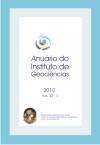Foraminifera, thecamoebians and palynomorphs as hydrodynamic indicators in Araguari Estuary, Amazonian Coast, Amapá State - Brazil
DOI:
https://doi.org/10.11137/2010_2_52-65Abstract
The Araguari estuarine dynamics is singular among traditional models of estuaries under tidal regime due to influence of macrotidal and tidal bore. In order to establish estuarine zones in Araguari according foraminifera, thecamoebians, paliynomorphs and physical-chemistry parameters, sixteen sample stations were established along the estuary. Turbidity and temperature were the environmental parameters which allowed determination of the estuarine gradient. Eighteen species of foraminifera, ten of thecamoebians and fourteen of particulate organic matter types were identified. Cluster analysis in R-mode showed three microorganism assemblages and four palynomorph ones. The CCA analyze shows turbidity and total organic matter with the most influence over foraminiferal and thecamoebians distribution at Araguari. Clustering analysis in Q-mode using all data formed four groups suggesting three estuarine zones in Araguari: Zone I composed of thecamoebian species and continental palynomorphs; Zone II - composed by mangrove foraminifera, thecamoebians and all palynomorph assemblages; and Zone III - composed by mangrove and estuarine foraminifera and all palynomorph assemblages.Downloads
Download data is not yet available.
Downloads
Published
2010-12-01
How to Cite
Laut, L. L. M. (2010) “Foraminifera, thecamoebians and palynomorphs as hydrodynamic indicators in Araguari Estuary, Amazonian Coast, Amapá State - Brazil”, Anuário do Instituto de Geociências. Rio de Janeiro, BR, 33(2), pp. 52–65. doi: 10.11137/2010_2_52-65.
Issue
Section
não definida
License
This journal is licensed under a Creative Commons — Attribution 4.0 International — CC BY 4.0, which permits use, distribution and reproduction in any medium, provided the original work is properly cited.















